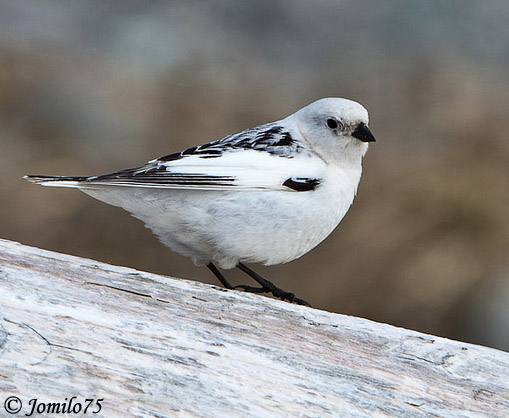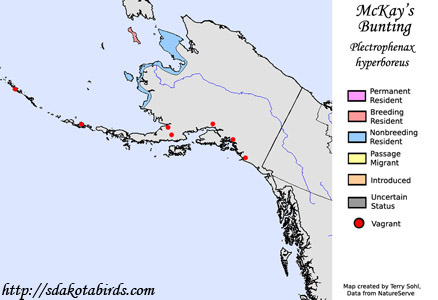| Length: 6.75 inches | Wingspan: 14 inches | Seasonality: Non-resident in South Dakota |
| ID Keys: Breeding birds mostly white, some black on wings, females with rusty markings on head and shoulders. Non-breeding birds with slightly more black or rust color on back | ||
 The
McKay's Bunting is likely one of the least seen of North American birds, as
it only is found on a few remote islands in the Bering Sea in the summer,
and in winter typically only migrates as far as western Alaska. They
are very closely related to the Snow Bunting,
and the two species have even been noted to interbreed. Total global
populations of the species are no more than a few thousand birds. They
are the whitest of the North American songbirds, with males in breeding
plumage only having a little bit of black on the wings.
The
McKay's Bunting is likely one of the least seen of North American birds, as
it only is found on a few remote islands in the Bering Sea in the summer,
and in winter typically only migrates as far as western Alaska. They
are very closely related to the Snow Bunting,
and the two species have even been noted to interbreed. Total global
populations of the species are no more than a few thousand birds. They
are the whitest of the North American songbirds, with males in breeding
plumage only having a little bit of black on the wings.
Habitat: They can be found breeding in a variety of habitats in their extremely limited range on the Bering Sea islands of St. Matthew and Hall Islands, including rocky tundra or rocky beaches. In winter they are found on beaches and nearby areas near the coast.
Diet: Feeds on insects and spiders in summer. Seeds also make up a big portion of the diet, and are the primary diet in the winter. They may also occasionally feed on very small marine invertebrates along the coast.
Behavior: Usually gregarious outside of the breeding season, feeding in flocks. Foraging is done by walking and running along the ground.
Nesting: The nest is found in a protected crevice among the rocks, or in a cavity in a cliff face or piece of driftwood. The nest is built of grasses and other herbaceous vegetation. Other details on nesting are poorly understood, but it is likely that the female does the majority of the incubation of eggs, while both parents help to feed and raise the young.
Song: Song of the McKay's Bunting is low throaty warbling. The song of the McKay's Bunting is evidently nearly identical to the Snow Bunting.
Migration: Summer breeding grounds are isolated islands in the Bering Sea. Wintering birds are thought to mostly migrate to the west coast of Alaska, and they are only very rarely found away from their normal range.
Interactive eBird map: Click here to access an interactive eBird map of McKay's Bunting sightings
Similar Species: Snow Bunting
Conservation Status: Total global populations of the species are no more than a few thousand. Populationscurrently appear stable, but given the small range and population of the species, habitat loss or other disruption could seriously endanger the species. The IUCN currently lists the McKay's Bunting as "near threatened".
Further Information: 1) American Bird Conservancy - McKay's Bunting
2) Audubon Field Guide - McKay's Bunting
3) BirdWeb.org - McKay's Bunting
Image Information: Photo by Jomilo75 - May 31st, 2009 -Saint Matthew Island, Alaska - Photo licensed through Creative Commons Attribution-Non-Commercial-NoDerivs 2.0 Generic License.
| Click below for a higher-resolution map |
 |
| South Dakota Status: Non-resident in South Dakota |
Additional McKay's Bunting Photos (Coming soon)
